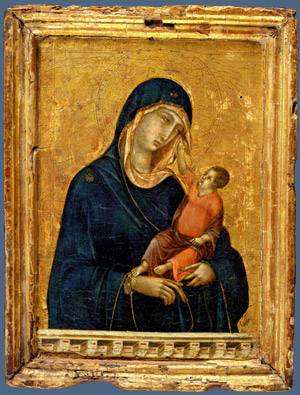Duccio Duccio (1255/60–1315/18) was an important representative of the Siena School, and he and Giotto were contemporaries. Art historians have always compared him to Giotto, but in fact the styles of the two are not the same, and such comparisons are often unfavorable to Duccio.
Duccio was a painter of the late Middle Ages, a mixture of Gothic and Byzantine styles, and Compared with Giotto's realist narrative style, Duccio injected more emotion and humanity into his works.
Although Duccio was a Native of Siena and typical of the Siena school, he was sometimes commissioned by Florentine patrons, and his rucellai Madonna for the Florence Cathedral is currently housed in the Uffizi Gallery. Later generations usually saw the painting as the work of Cimabue Chimabue, and this view lasted for many years. Although art history has been biased against Duccio for a long time, many famous museums still attach great importance to his works, and in 2004, the Metropolitan Museum of Art in New York purchased a work "Madonna and Child" created by Duccio in 1300 at a considerable price, which is said to have sold for $45 million.

Madonna and Child 1300年
Like Giotto, little is known about Duccio's previous experiences in painting, internships, etc., and his most famous work is the Maestà (Pietà), a religious subject that was widely seen in the Middle Ages. But only Ducho's work can be called a "master" level. In 1260, Siena won a war with Florence, which was regarded as the credit of the Virgin Mary, and the day after the Feast of the Assumption, the citizens of Siena worshipped the Virgin Mary as the patron saint of Siena.
This veneration also explains where the joy of the people came from when the large altarpiece of Maestà was placed in the Cathedral of Siena in 1311.
Maestà 1311
It was recorded at the time that on June 9, 1311, the Siena people marched gleefully through the streets, carrying this great work and celebrating this happy day. As someone later said: Art used to be the center of culture, but today it is only on the margins of society.
Unfortunately, today's Maestà top and bottom are badly damaged, and it has undergone several major restorations so far. The original painting was 13.5 feet wide and seven feet high, twice the size of Giotto's work in the Arenal Chapel. Maestà has both front and back, and some of the paintings at the bottom are very small. Unlike frescoes, Maestà uses tempera techniques. The so-called tempera painting is a mixture of basic pigments with diluted egg yolks, and because the tempera dries very quickly, it can only be painted on a small area of wood. Gold is often used as the entire background of tempera paintings, which greatly increases the reflection of light and looks golden and full of divinity.
In 1505 Maestà was moved to a chapel next to the Siena Cathedral, and more than two hundred years later, in 1771 the panelled paintings on the top and bottom of it were demolished and sold by the clergy of the church, so that we can now see parts of the fragments of Maestà in Washington, New York, and London, and the rest of it, which were eventually preserved in the church museum in Siena, until now.
The front of this painting is the Virgin and Child, as well as the apostles and angels, and what is to be explained here is that because the altarpiece itself is very large, we can see it clearly since we are far away. The lower row is seven scenes of Christ's infancy (which must be seen up close), and the upper row of small paintings is a scene of Mariard's life.
The first painting on the left in the lower row, The Annunciation, is now preserved at the National Gallery in London. Notice the angels' clothes and colors and the architectural space in the middle.
Annunciation Angel Annunciation
Nativity of the Nativity, now at the National Gallery of Art, Washington, D.C.,
Nativity Christ was born
This image shows a combination of stability (European tradition) and cave (Byzantine tradition). The Virgin is leaning on a Romanesque mattress, and the newborn Jesus appears both in the bath in the foreground and in the cradle in the background, and it is interesting to take a closer look at the naturalistic painting of several sheep below.
Looking at the reverse side of Maestà, below is our reconstruction, which includes several works that have disappeared. Because they are the opposite of the altarpiece, these works can only be seen by the monks of the church and the members of the church choir. Looking at some of the more important ones, the first is The Temptation of Christ.
Maesta on the reverse
According to Matthew and the Gospel of Luke, Satan tempted Jesus three times. The third time it took Jesus up a mountain and showed him all the kingdoms of the world, saying, "As long as you are willing to bow down and worship me." Jesus replied, "Satan, go behind me, and you will worship the Lord, the only God to be worshipped."
Temptation of Christ
Duccio imagines all the countries of the world as walled Siena, and that's probably why he's especially loved by the people of Siena.
Look again at this painting of Calling of Peter and Andrew. Notice the golden ground, the outstretched hand of Christ, and the waves of the water and the fish in it, the picture is very clear.
Calling of Peter and Andrew The Call of Peter and Andrew
Finally look at this Crucifixion (Crucifixion).
Crucifixion Crucifixion Crucifixion Crucifucation
In contrast to Giotto's more theological and symbolic Crucifixion at Arena Chapel, Duccio's shows a narrative scene in which all three crosses are in a noisy crowd, with characters with a variety of expressions, from fear and hatred to silence and sadness, but emotions remain restrained.